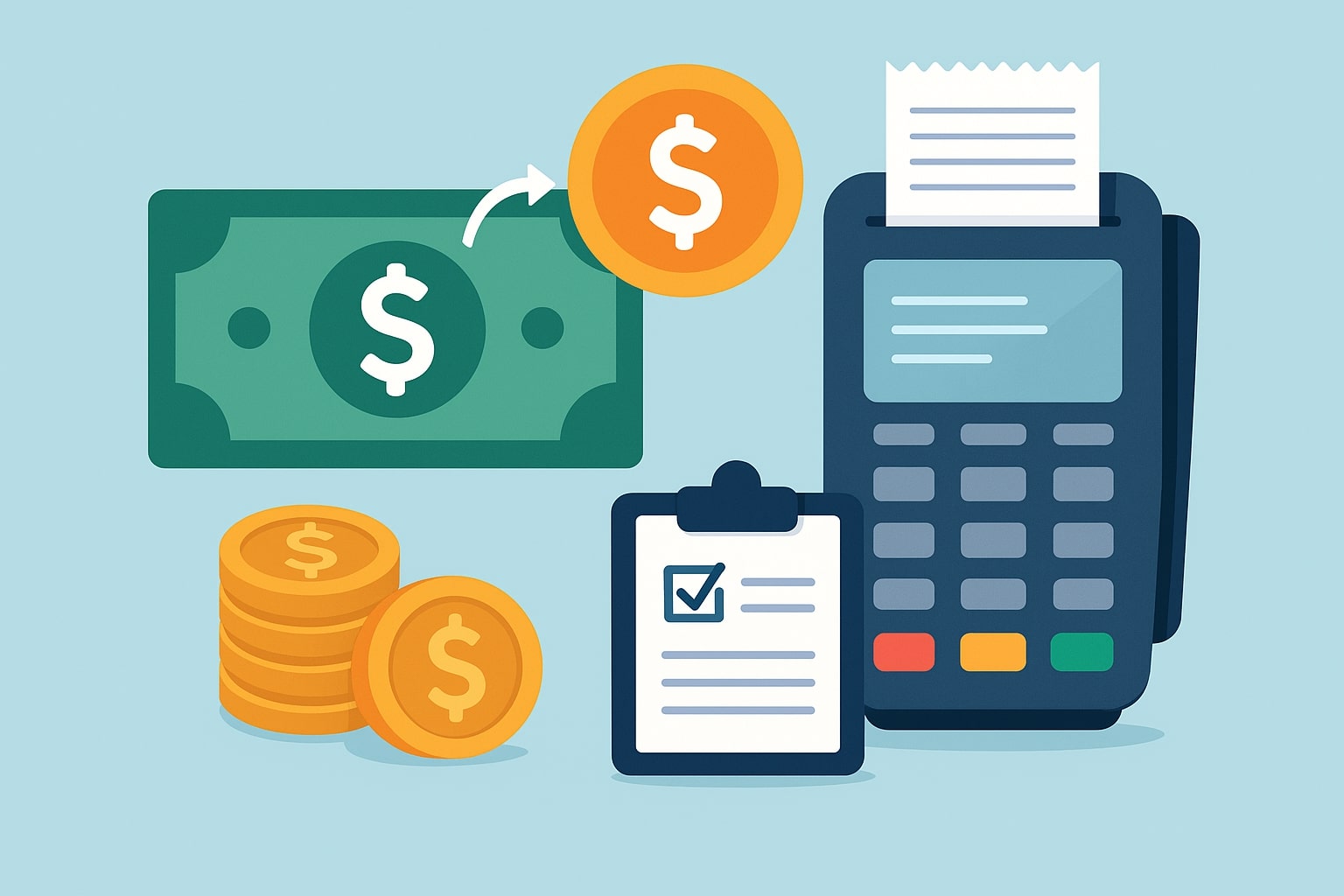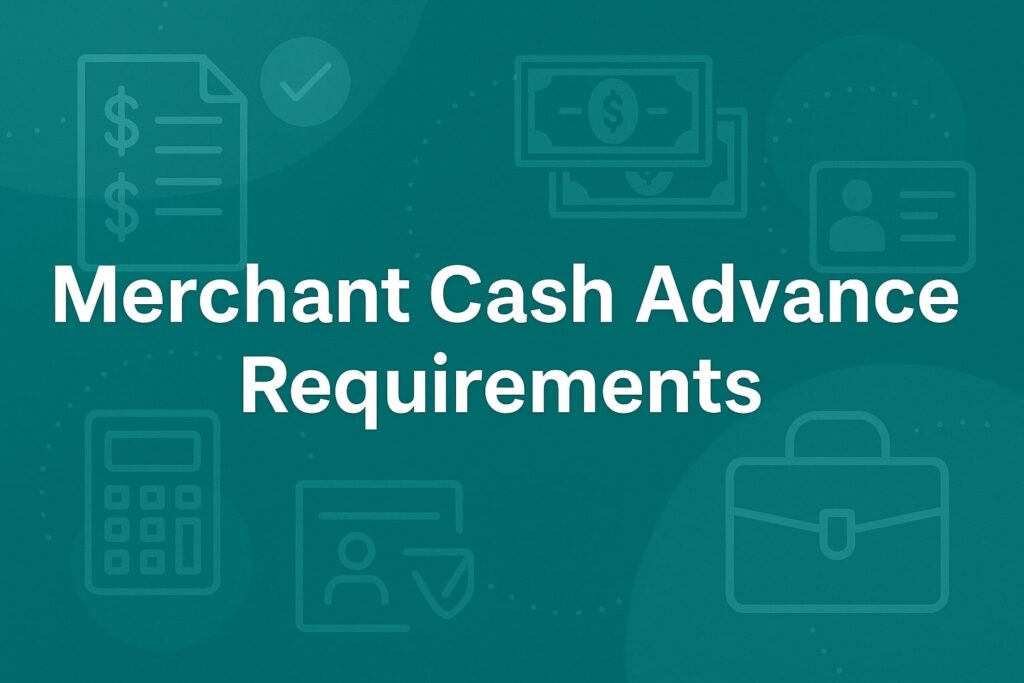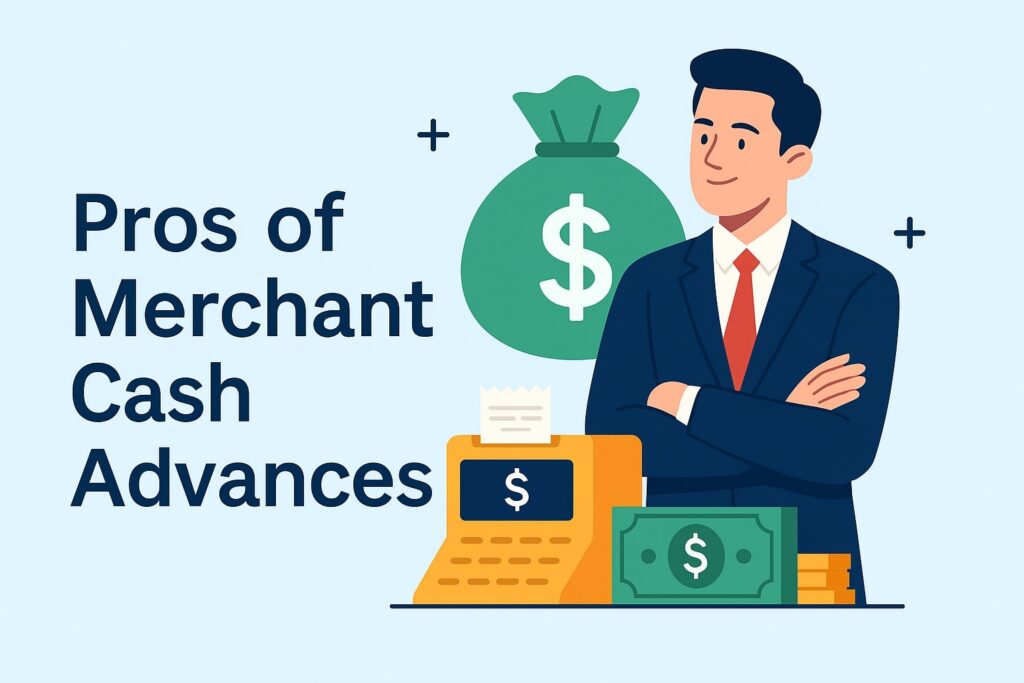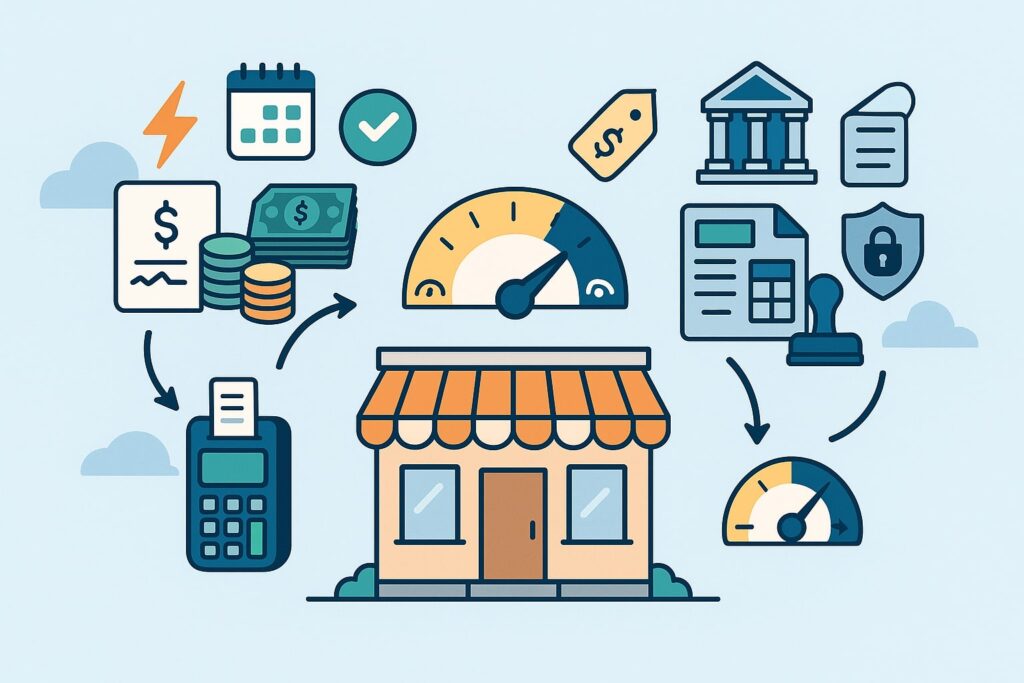
How Merchant Cash Advances Work
A merchant cash advance (MCA) is a form of short-term business financing where a lender provides a lump-sum payment in exchange for a percentage of the business’s future credit/debit card sales or revenues.
Rather than a traditional loan, MCAs involve “selling” future receivables. For example, a restaurant might receive $10,000 today from an merchant cash advance provider and agree to repay $13,000 by remitting a fixed percentage (say 10–20%) of its daily card sales until the $13,000 is collected.
Because the repayment comes out of daily sales, it flexes with revenue – higher sales mean larger payments and vice versa. MCAs typically have short terms (often 6–12 months) and are repaid quickly through daily or weekly debits from the merchant’s account.
Merchant cash advances have seen rapid growth. The global MCA market was valued at $17.9 billion in 2023 and is projected to reach $32.7 billion by 2032 (a compound annual growth rate of ~7.2%).
This surge reflects strong demand among U.S. small businesses for alternative funding when bank loans are hard to obtain. In fact, only about 21.6% of small business loan applications are approved by major banks, whereas merchant cash advance providers approve roughly 84% of applications (U.S. Fed study, 2020).
MCAs offer almost instantaneous cash (often within 24–48 hours) and minimal paperwork, making them attractive to startups or companies in crisis that need working capital fast.
How Do Merchant Cash Advances Work?
A merchant cash advance essentially gives you cash today in exchange for a fixed percentage of your future sales. The process generally follows these steps:
- Application and Approval: The business applies with some basic financials. The merchant cash advance provider reviews recent credit/debit card transactions (or bank deposits) to assess revenue.
Unlike bank loans, MCAs focus on business performance and typically require only a few months of statements, so even startups (6–12 months old) may qualify. - Receiving the Advance: Once approved, the lender deposits a lump sum into the business bank account (e.g. $20,000). Funding is very fast – often within a day or two of approval.
- Repayment via Sales: The business repays the advance by allowing the lender to automatically take a fixed holdback percentage of each day’s credit/debit card sales (or a scheduled ACH debit from its bank account).
For example, if the holdback is 10%, the lender takes $100 for every $1,000 in daily sales. - Factor Rate and Total Payback: Instead of traditional interest, MCAs use a factor rate (e.g. 1.20 to 1.50). The repayment amount equals the advance multiplied by the factor rate. For instance, with a factor rate of 1.3, a $10,000 advance requires $13,000 total repayment. That $3,000 premium is effectively the financing cost.
Because the advance is paid off over, say, 6 months, the implied APR can be very high (often 50–200% or more). - Completion: Daily debits continue until the total (advance + factor fee) is collected. Once repaid, the agreement ends. If sales are slower, repayment takes longer; if sales spike, it finishes sooner, but the total paid stays the same.
(Importantly, because MCAs are structured as sales of future receipts rather than loans, many providers forgive any remaining balance if a business shuts down.)
In summary, MCAs give businesses speed and flexibility: lenders take on sales risk and get paid out of revenue. There are typically no fixed monthly payments or deadlines (just the sales holdback). However, these perks come at a cost (see below).
Merchant Cash Advance Requirements

Merchant cash advances are easier to qualify for than bank loans, but lenders still look for certain business fundamentals. Typical merchant cash advance requirements include:
- Business Age: Most merchant cash advance providers require at least 3–6 months in business (some require longer). They want evidence of an ongoing operation.
- Monthly Sales Volume: Consistent credit/debit card or bank deposit revenue is crucial. Many providers look for at least $5,000–10,000 in average monthly sales. This reassures the lender that the business can generate the needed repayments.
- Bank and Processing Statements: Applicants usually submit recent bank statements and card processing statements (often 3–6 months’ worth). Lenders use these to verify cash flow and calculate your advance offer.
- Credit Score: Unlike banks, MCAs do not rely heavily on personal or business credit scores. Lenders focus more on revenue. However, some merchant cash advance firms may check credit history as a formality. A credit score as low as the high 400s or 500s often will still qualify.
- Ownership and Legal Documents: Basic business documentation is needed: business tax ID, owner’s ID (e.g. SSN), a voided check or account info, and sometimes a lease or incorporation papers. But there is little to no collateral requirement.
- Credit Card Processor Agreement: If the advance is repaid via a processor, some contracts require you to stay with a particular payment processor while repaying.
In practice, many MCAs are available to businesses that lack strong credit or traditional collateral. As one industry resource notes, MCAs accept companies with 6+ months of history and ~$5K+ in monthly sales, making them accessible to newer or riskier ventures that banks would turn down.
Pros of Merchant Cash Advances

Merchant cash advances offer several advantages for businesses that need quick cash. Key benefits include:
- Fast Access to Cash: Funding is extremely quick. merchant cash advance companies often approve and fund advances in 24–48 hours, far faster than banks. This can bridge urgent cash flow gaps (e.g. payroll, inventory restocking, emergency repairs) when time is short.
- Flexible Repayment: Repayments fluctuate with your sales. In a slow month you pay less; when sales rise you pay more. This can ease pressure during seasonal downturns or unexpected slumps. (For example, if a quiet February reduces card sales, the holdback is smaller automatically.)
- High Approval Rates: MCA providers are much more lenient than banks. According to the Federal Reserve, roughly 84% of merchant cash advance applications were approved in 2020, compared to only ~57% for traditional business loans.
One infographic notes only 21.6% of bank loan requests are approved. In short, if you can prove revenue, you’ll likely get funding. - Minimal Credit/Creditworthiness Requirements: MCAs prioritize business performance over credit score. Even companies with poor or no credit can often qualify, making MCAs attractive to startups or distressed businesses.
- No Collateral or Personal Guarantee: Most MCAs are unsecured. Your business assets or owner’s home are not used as collateral.
If the business fails, you generally owe nothing further (the merchant cash advance provider simply stops collecting), so the risk to the owner’s personal assets is limited. - Short Application Process: The paperwork is light—often a simple one-page application. Lenders make decisions quickly using automated underwriting, so you can avoid lengthy loan interviews or piles of documents.
- Automatic Payments: Because payments are automatic (through the payment processor or bank ACH), there are no late fees or missed deadlines as long as sales continue. (There are also no minimum payments; if you have no sales on a day you simply pay nothing that day.)
These pros make MCAs a “lifeline” for small businesses with urgent needs. For example, a seasonal retailer with low winter sales could prefer an merchant cash advance because its payments shrink in the slow season, helping it stay afloat until spring.
In general, MCAs provide quick, easy cash with flexible, revenue-based payback, which can be invaluable when alternatives are limited.
Cons of Merchant Cash Advances

However, the benefits come at a steep cost and risk. The main drawbacks of merchant cash advances include:
- Very High Cost (Effective APR): MCAs charge a large fee via the factor rate. In practice, the effective Annual Percentage Rate (APR) can range from 50% up to 200% or more.
For example, one finance expert found merchant cash advance customers paying APRs “north of 150%” without realizing it. In contrast, an SBA loan might have ~7% interest. Thus, MCAs are far more expensive than almost any other financing. - Short-Term, Lump-Sum Only: MCAs are designed for short-term needs. Typical repayment is 6–12 months (sometimes up to 24), so they are not suited for long-term investments or large expansion.
You also receive a one-time lump sum, not a revolving line of credit, so you must reapply for additional funds later. - Daily/Weekly Cash Drain: Since payment comes out of each day’s receipts, even a shortfall in revenue can seriously hurt cash flow.
If sales suddenly drop, you’ll still have to make the daily payment (you’re paying off past borrowing), which can create a vicious cycle. A business with unpredictable sales must be cautious: missing revenue means still owing the advance principal. - Strict Contracts and Fees: MCA contracts often have fine print. Some require you to keep the same credit card processor and prohibit switching without penalty. Fees may change over time, and some providers may impose hidden administrative charges.
Because MCAs are legally “purchases of receivables” not loans, they fall outside many lending regulations, so borrowers have fewer consumer protections. - No Savings from Early Payoff: With traditional loans, paying early saves interest. With an MCA, the factor rate is fixed; paying faster does not reduce the fee. You pay the same total even if you repay in 3 months instead of 6.
- Can Be Debt Trap: If misused, MCAs can lead to a debt spiral. Because daily remittance continues regardless of profit, a struggling merchant might deplete its operating funds to cover the holdback.
Some businesses take one MCA to repay another. Financial experts warn that MCAs “can leave small business owners in poor financial shape” if they don’t have a clear plan. - Better Options Exist: Often, other funding sources cost far less. For instance, a bank loan or SBA-backed loan might offer a similar amount at one-tenth the effective rate. Experts usually advise owners to check for any available loans or lines of credit before resorting to an MCA.
In summary, the major con is cost. You trade high fees and constant payment demands for speed and leniency. If the business cannot comfortably handle daily repayments, an MCA can worsen cash shortages. Always calculate the true APR of an MCA (using factor rates) and compare to other options.
Merchant Cash Advance vs. Other Financing Options

Small businesses have many funding choices. MCAs can be compared to these common alternatives:
- SBA 7(a) Loans: These government-backed loans allow up to $5 million at much lower interest (often 7–10%). However, SBA loans involve lengthy applications, strict criteria (e.g. 2+ years in business, high credit score), and collateral requirements.
Funding can take weeks or months. By contrast, an MCA has no collateral, minimal paperwork and funds immediately, but costs far more in fees. - Business Line of Credit (LOC): A LOC is like a business credit card. You get approved for a limit (say $50k–$500k) and draw as needed. You pay interest only on amounts borrowed and can repay and reuse funds.
LOCs typically have moderate rates (often 8–25%), require decent credit and a bit of history, and can be funded in days. They offer flexibility that MCAs lack (you only borrow what you need), and any unused credit is ready for emergencies.
Repayments are usually monthly, not daily, making cash flow easier. However, banks can still deny a LOC application if credit or revenue is weak. - Invoice Factoring: If your business sells on credit (invoicing customers), factoring firms buy your outstanding invoices for immediate cash (typically 70–90% of face value). You then repay the factor when your customer pays the invoice.
Factoring fees (1–5% of the invoice) are often lower than MCA fees. But factoring only works if you have B2B receivables and creditworthy clients. It, too, provides quick cash but with more stable payment terms (tied to payment date, not a fixed holdback). - Equipment Financing/Loans: For buying equipment, you can use an equipment loan or lease, which uses the equipment as collateral. These loans often have reasonable interest rates and terms aligned to the equipment’s life.
- Traditional Bank Loans: Unsecured or secured small business loans from banks can offer low rates, but they require strong credit, collateral, and take weeks to process.
The table below highlights key differences between MCAs, SBA loans, and a typical business line of credit:
| Feature | Merchant Cash Advance | SBA 7(a) Loan | Business Line of Credit |
|---|---|---|---|
| Funding Speed | ~1–2 days | Typically weeks | Days–weeks (often <1 week) |
| Repayment Terms | Daily/weekly fixed % of sales | Fixed monthly payments | Flexible (borrow & repay on demand) |
| Collateral | None (non-recourse) | Usually required (or guaranty) | Usually unsecured (may require guarantee) |
| Typical Cost | Very high (factor rate; APR ~50–200%+) | Low (often 7–10%) | Moderate (interest only on used amount) |
| Eligibility | Lenient (few months’ revenue; credit less important) | Strict (good credit; 2+ years in biz) | Moderate (credit and business history) |
| Borrowing Limit | Based on daily sales volume | Up to ~$5 million | Up to a set limit (e.g. $50k–$500k) |
| Use Case | Short-term cash needs (inventory, payroll) | Major investments, growth, real estate | Ongoing working capital, cash flow buffer |
In practice, MCAs make sense when speed and access outweigh cost concerns. They are best for small, short-term cash needs in the U.S. market where traditional financing isn’t available. For larger or longer-term funding, SBA loans or a line of credit are almost always cheaper.
Payment processor financing (e.g. Square Advance, PayPal Working Capital) is another related option; these use similar mechanics (fixed fees, repayments from sales) but often at somewhat lower factor rates (e.g. 1.10–1.16).
Latest Trends and Statistics
- Skyrocketing Market: The MCA industry is growing fast. Allied Market Research reports the global merchant cash advance market was $17.9B in 2023 and is projected to $32.7B by 2032. North America is the largest regional market, driven by the U.S. demand.
- Approval Rates vs. Loans: According to Federal Reserve data, MCAs have by far the highest small-business approval rates.
In 2020 the MCA approval rate was about 84% (similar to equipment financing), whereas conventional small business loans were approved only ~57% of the time.
By contrast, only around 22% of bank loan requests are approved, making MCAs a low-barrier option. - Declining Interest Spreads: Some industry sources claim that MCA factor rates are gradually decreasing as competition intensifies. However, they remain substantially higher than bank rates.
Even so, regulators and trade groups are pushing for more transparent disclosures. For example, Connecticut recently enacted laws requiring MCA providers to clearly state the factor rate and repayment percentage. - Tech Acceleration: Fintech has streamlined MCAs. Automated underwriting and data analysis allow underwriting in hours, as noted in industry reports. Many online MCA lenders now offer same-day funding decisions for qualified applicants.
- Usage: A Federal Reserve survey found that about 8% of small businesses have used a merchant cash advance at some point. Owners often turn to MCAs for seasonal inventory buildup, advertising campaigns, or to bridge payroll during downturns.
In short, MCAs are a booming segment of alternative small-business finance, reflecting both the needs of “credit-rationed” businesses and the rise of online lenders.
However, experts caution that much of this growth comes with risk: MCAs’ high costs and debt-load implications mean regulators and advisors advise careful consideration.
Frequently Asked Questions
Q.1: Is a merchant cash advance a loan?
Answer: No. Technically an MCA is not a loan because the borrower isn’t obligated to pay a fixed monthly principal plus interest. Instead, the merchant sells future receivables. You receive cash upfront and the MCA provider collects a percentage of your future card sales. Because of this sale structure, MCAs are not subject to standard usury laws (there’s no stated interest rate or APR by law).
Q.2: How much does a merchant cash advance cost?
Answer: The cost is built into the factor rate. For example, a factor rate of 1.30 means you’ll pay back $13,000 on a $10,000 advance. There is no conventional interest rate or amortization schedule. The effective APR depends on how quickly you repay.
As one analysis notes, a $30,000 advance with a $9,000 factor fee (1.30 rate) is far more than a 30% APR loan – in practice it’s closer to 50% APR or higher. Additional fixed fees (origination or processing fees) may apply.
Because MCAs are short-term, the same factor rate yields a higher effective APR if the term is shorter. In sum, MCAs have very high financing costs – often equivalent to 50–200% APR.
Q.3: What are the typical requirements to qualify?
Answer: Lenders mainly look at your revenue and history, not just credit. You typically need at least 3–6 months in business and steady monthly sales (commonly $5K+ per month).
You’ll submit recent bank statements or credit card processing statements and basic business documents (tax ID, bank account info, etc.). Few MCA providers require a minimum credit score, though they may check your credit report out of diligence.
Higher sales volume generally allows for larger advances. Different funders have slightly different criteria, but overall MCAs are accessible to businesses that might not qualify for traditional loans.
Q.4: Is a merchant cash advance legal?
Answer: Yes. MCAs are legal because they are structured as sales of future income, not loans. Thus providers are not bound by lending regulations in the same way as banks. However, because of the high rates, regulators are paying more attention.
Several states (e.g. Connecticut) now require MCA contracts to be transparent about factor rates and holdback amounts. Experts advise borrowers to read all terms carefully.
Q.5: How does an MCA impact my credit?
Answer: Obtaining an MCA generally won’t directly hurt your credit score, because it’s not a traditional loan reported to credit bureaus. MCA providers focus on your business revenue, so even poor personal/business credit won’t automatically disqualify you.
However, the provider may do a soft or hard credit inquiry. Still, whether or not you have an MCA won’t significantly move your credit score.
Q.6: When is a merchant cash advance a good idea?
Answer: MCAs are best for short-term cash needs when speed is critical and other financing isn’t available. Good use cases include bridging a cash flow gap, quickly seizing a growth opportunity (e.g. bulk inventory purchase), or covering emergency expenses.
They work well for businesses with high and predictable card sales who are confident they can handle daily remittances. However, MCAs are generally discouraged for funding long-term investments or for companies with very tight margins.
Financial advisors recommend first exploring SBA loans, lines of credit, or business credit cards, since those options typically carry much lower interest. If no conventional financing is available and your business urgently needs cash, an MCA can be a viable fallback.
Conclusion
Merchant cash advances (Business Merchant Cash Advances) offer small businesses rapid, flexible access to capital by advancing on future sales. They require minimal documentation and often approve applications that banks would reject.
As one legal analysis notes, MCAs provide “quick access to capital without the stringent requirements typical of traditional bank loans”. For small firms with short-term funding needs and modest sales history, MCAs can fill a gap and keep operations running.
However, that convenience comes with significant trade-offs. MCAs are extremely expensive financing. The factor rates charged can translate into APRs well above 50%, sometimes over 100% or more. The daily repayment structure can strain cash flow if not carefully managed.
In the U.S. market, where alternatives exist, it’s usually wise to exhaust cheaper options first. For example, an SBA 7(a) loan might offer up to $5 million at ~7–10% interest (compared to the 50–200%+ APR of an MCA). Many experts advise business owners to “always check whether a business loan is available before taking an advance”.
In summary, a merchant cash advance is a workaround solution: a trade of speed and leniency for higher cost. When used judiciously – for immediate cash flow needs and when no other funds are available – an MCA can provide vital liquidity.
But because of the high financing charges, a business should carefully review the merchant cash advance requirements, fully understand the factor rate and holdback terms, and consider less-costly loans or lines of credit wherever possible.